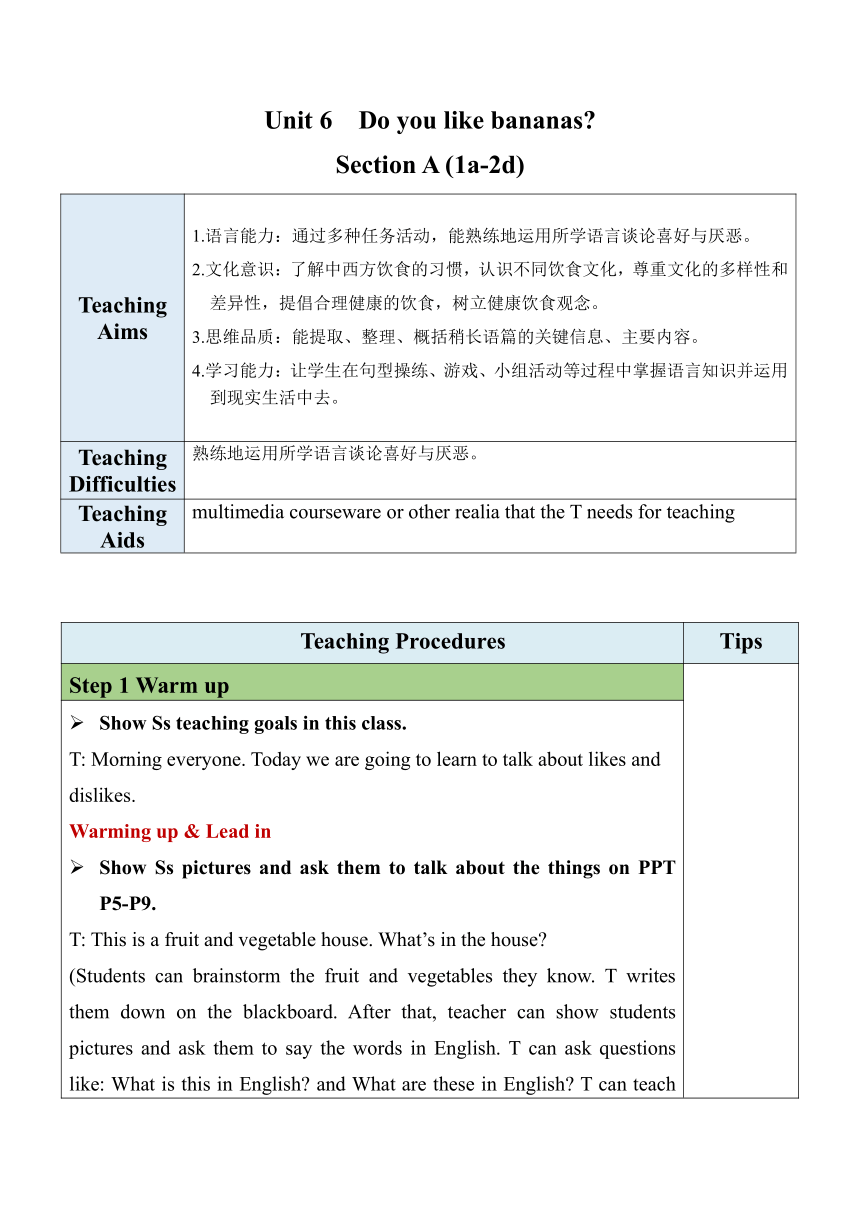
Unit 6 Do you like bananas Section A (1a-2d) Teaching Aims 1.语言能力:通过多种任务活动,能熟练地运用所学语言谈论喜好与厌恶。 2.文化意识:了解中西方饮食的习惯,认识不同饮食文化,尊重文化的多样性和差异性,提倡合理健康的饮食,树立健康饮食观念。 3.思维品质:能提取、整理、概括稍长语篇的关键信息、主要内容。 4.学习能力:让学生在句型操练、游戏、小组活动等过程中掌握语言知识并运用到现实生活中去。 Teaching Difficulties 熟练地运用所学语言谈论喜好与厌恶。 Teaching Aids multimedia courseware or other realia that the T needs for teaching Teaching Procedures Tips Step 1 Warm up Show Ss teaching goals in this class. T: Morning everyone. Today we are going to learn to talk about likes and dislikes. Warming up & Lead in Show Ss pictures and ask them to talk about the things on PPT P5-P9. T: This is a fruit and vegetable house. What’s in the house (Students can brainstorm the fruit and vegetables they know. T writes them down on the blackboard. After that, teacher can show students pictures and ask them to say the words in English. T can ask questions like: What is this in English and What are these in English T can teach Ss countable nouns and uncountable nouns. T needs to correct Ss’ grammar mistakes.) Step 2 Presentation & Practice (1a-1c) Pre-listening 1a Ask Ss to match the words with the things in the picture. (This part is about words, so T can encourage B level Ss to answer easy questions to build their confidence. Ask Ss to read the words one by one to make sure they can pronounce the words correctly. ) Answers: 1. a, 2. i, 3. f, 4. h, 5. b, 6. g, 7. c, 8. j, 9. e, 10. a Ask Ss to read the dialogue in the picture together. While-listening 1b Ask Ss to listen and number the conversations [1-3] in 1b. T: Some people are buying something in the shop. What are they going to buy Now let’s listen and number the conversations [1-3] in 1b. (Tip: After Ss shared their answers, Ss can read the scripts or watch a video to get more familiar with the sentence patterns: Do you like … Yes, I do / No, I don’t. ) Answers: 1 2 3 1c In 1c, have Ss act out the scene, imitating the setting and location of the speakers. Arrange the desks in your classroom to resemble cafeteria tables and a food counter. Have some Ss stand in line where the imaginary food counter would be. Have other Ss sit at their desks where the imaginary cafeteria tables would be. Encourage Ss to act out the conversations on location! Step 3 Language points learning (1a-1c) 可数名词与不可数名词的用法: 可数名词是能直接以数目进行计算的 名词,如banana, hamburger,tomato, orange, strawberry, pear。可数名词有复数形式。 不可数名词是不能直接以数目进行计算 的名词,如milk,bread。不可数名词一般没有复数形式。 tomato是可数名词,其复数形式是在词尾加-es,即tomatoes。 以-o结尾的需加-es构成复数的可数名词:英雄(hero)爱吃西红柿(tomato)和土豆(potato)。 strawberry是可数名词,其复数形式把y变i,加-es, 即strawberries。 以辅音字母+y结尾的可数名词变复数,要变y为i再加-es; 以元音字母+y结尾的可数名词变复数,直接在词尾加-s。 ice ... ...
~~ 您好,已阅读到文档的结尾了 ~~

